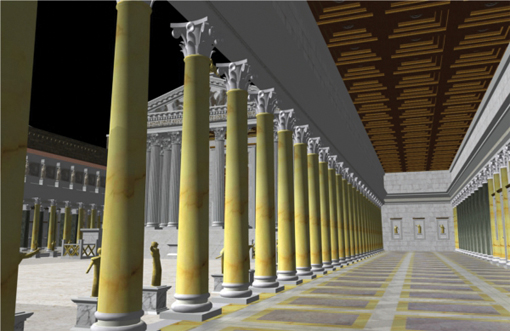Virtual Rome

Forum Augustum inside portico
The emperor Augustus built this splendid Forum to celebrate his new regime’s power, wealth, and lineage. The colourful marbles used came from across Rome’s expanding empire (image © Dr Matthew Nicholls)
A project like this has to draw on many different types of evidence, from the study of archaeological remains to literary accounts and inscriptions and the tantalizing surviving fragments of the Forma Urbis, a giant marble map of the city made in the early 3rd century AD. Where specific evidence is lacking – as for large areas of the city’s residential districts, which survived and were documented less well than the grand monuments – a measure of (educated) guesswork is needed, with analogy on the basis of what evidence does survive. Handling this range of evidence and its interpretation is a familiar part of the academic discipline of ancient history, but digital modelling is a new way of articulating and presenting historical enquiry, both for teaching and research.
This combination of a relatively new visual, digital medium with traditional disciplinary research skills appeals to students. After using my digital work in teaching, and explaining how I had made it, I found that our undergraduate and postgraduate students wanted to try it for themselves. To enable them to do this, I developed a new third-year undergraduate module, called ‘Digital Silchester’, which they can take as part of their degrees in Classics, Ancient History, or Classical Studies. The aim is to research and create a digital model of a building from our local Roman site of Silchester (excavated over the last twenty years by our own Archaeology Department), using free SketchUp modelling software. The chance to gain academic credit in an innovative digital, visual medium rather than a conventional essay or exam answer appeals strongly to many students, and I have seen some very imaginative and successful models made after a single term’s tuition.
My own digital work, meanwhile, has appeared in Discovery Channel and BBC documentaries, in BBC History Magazine, History Today, National Geographic Storica, and other popular publications; I am also currently writing a book based on it for Cambridge University Press. With recognition in the 2013 BUFVC Learning on Screen Awards, and as the winner of the 2014 national Guardian Higher Education Award for Teaching Excellence, I hope this project shows that digital visualisation can contribute a lot to research and teaching practice, even for academics and students without previous experience. Download some software and give it a go!
Dr Matthew Nicholls
www.reading.ac.uk/classics/research/Virtual-Rome.aspx
 Learning on Screen
Learning on Screen